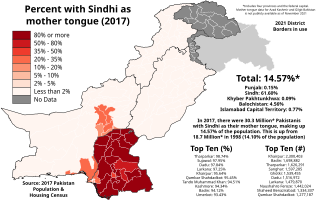
Punjabi, sometimes spelled Panjabi, is an Indo-Aryan language native to the Punjab region of Pakistan and India. It is one of the most widely spoken native languages in the world with approximately 150 million native speakers.

Pakistan is a multilingual country with over 70 languages spoken as first languages. The majority of Pakistan's languages belong to the Indo-Iranian group of the Indo-European language family.

Eastern Armenian is one of the two standardized forms of Modern Armenian, the other being Western Armenian. The two standards form a pluricentric language.

Sindhi is an Indo-Aryan language spoken by about 30 million people in the Pakistani province of Sindh, where it has official status. It is also spoken by a further 1.7 million people in India, where it is a scheduled language, without any state-level official status. The main writing system is the Perso-Arabic script, which accounts for the majority of the Sindhi literature and is the only one currently used in Pakistan. In India, both the Perso-Arabic script and Devanagari are used.

Hindko is a cover term for a diverse group of Lahnda dialects spoken by several million people of various ethnic backgrounds in several areas in northwestern Pakistan, primarily in the provinces of Khyber Pakhtunkhwa and northwestern regions of Punjab.

Saraiki is an Indo-Aryan language of the Lahnda group. It is spoken by 28.84 million people, as per the 2023 Pakistani census, taking prevalence in Southern Punjab with remants in Northern Sindh and the Derajat region. This term was first introduced for the Multani, Riyasti and Derawali dialects of the Punjabi language in 1962 as a result of a political movement.

Pahari-Pothwari is an Indo-Aryan language variety of the Lahnda group, spoken in the northern half of Pothohar Plateau, in Punjab, Pakistan, as well as in the most of Pakistan-administered Azad Kashmir and in the western areas of Indian-administered Jammu and Kashmir. It is known by a variety of names, the most common of which are Pahari, and Pothwari.
Sikkimese is a language of the Tibeto-Burman languages spoken by the Bhutia people in Sikkim in northeast India, parts of Koshi province in eastern Nepal, and Bhutan. It is one of the official languages of Sikkim.

Hindustani, the lingua franca of Northern India and Pakistan, has two standardised registers: Hindi and Urdu. Grammatical differences between the two standards are minor but each uses its own script: Hindi uses Devanagari while Urdu uses an extended form of the Perso-Arabic script, typically in the Nastaʿlīq style.
Lahnda, also known as Lahndi or Western Punjabi, is a group of north-western Indo-Aryan language varieties spoken in parts of Pakistan and India. It is defined in the ISO 639 standard as a "macrolanguage" or as a "series of dialects" by other authors. Its validity as a genetic grouping is not certain. The terms "Lahnda" and "Western Punjabi" are exonyms employed by linguists, and are not used by the speakers themselves.

Hindkowans, also known as the Hindki, is a contemporary designation for speakers of Indo-Aryan languages who live among the neighbouring Pashtuns, particularly the speakers of various Hindko dialects of Western Punjabi (Lahnda). The origins of the term refer merely to the speakers of Indo-Aryan languages rather than to any particular ethnic group. The term is not only applied to several forms of "Northern Lahnda" but also to the Saraiki dialects of the districts of Dera Ghazi Khan, Mianwali, and Dera Ismail Khan, which border the southern Pashto-speaking areas.
The Gujarati language is an Indo-Aryan language native to the Indian state of Gujarat. Much of its phonology is derived from Sanskrit.
Punjabi is an Indo-Aryan language native to the region of Punjab of Pakistan and India and spoken by the Punjabi people. This page discusses the grammar of Modern Standard Punjabi as defined by the relevant sources below.

The Pashto alphabet is the right-to-left abjad-based alphabet developed from the Perso-Arabic script, used for the Pashto language in Pakistan and Afghanistan. It originated in the 16th century through the works of Pir Roshan.

The Punjabi dialects and languages or Greater Panjabic are a series of dialects and Indo-Aryan languages spoken around the Punjab region of Pakistan and India with varying degrees of official recognition. They have sometimes been referred to as the Greater Punjabi macrolanguage. Punjabi may also be considered as a pluricentric language with more than one standard variety.

Pashto dialects can be divided into two large varieties: Northern Pashto and Southern Pashto. Each of the two varieties of Pashto is further divided into a number of dialects. Northern Pashto is spoken in eastern Afghanistan, and central, northern and eastern Khyber Pakhtunkhwa. Southern Pashto is spoken to the south of it, in southern and western Afghanistan, southern Khyber Pakhtunkhwa and northern Balochistan. 'Ethnologue' divides Pashto into Northern, Southern and Central Pashto, and Wanetsi.

Thaḷī is a dialect within the Lahnda group spoken in parts of the Pakistani provinces of Punjab and Khyber Pakhtunkhwa. It is classified by some linguists as a northern dialect of Saraiki language, although it has also been described as transitional between Saraiki and Jhangvi-Shahpuri. Its name derives from the Thal Desert, in which it is spoken.
Dhani or Dhanni is a western dialect of the Punjabi language spoken in the southern region of the Pothohar Plateau in Punjab, Pakistan. It is predominantly spoken in the Chakwal and Talagang districts; as well as in the southern portions of Attock and Jhelum districts. Its name is derived from Dhan valley, located 35 km away from Rawalpindi. It has many subdialects including Sohāī̃, spoken west of the Soan River, in the tehsils of Fateh Jang and Pindi Gheb in Attock District.
Awankari is a Lahnda dialect spoken primarily in Talagang District, in the north-west of the Pakistani province of Punjab.

Ghebī (Hindko:گھیبی) is a dialect of Hindko, spoken in the north-west of the Pakistani province of Punjab. In the early 20th century Grierson assigned it to his "North-Western Lahnda" group, whereas Shackle writing in 1980 placed it within Hindko "proper" alongside Chacchī and Avāṅkārī.













